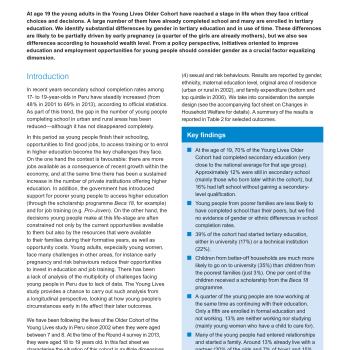
At age 19 the young adults in the Young Lives Older Cohort have reached a stage in life when they face critical choices and decisions. A large number of them had already completed school and many are enrolled in tertiary education. We identify substantial differences by gender in tertiary education and in use of time. These differences are likely to be partially driven by early pregnancy (a quarter of the girls are already mothers), but we also see differences according to household wealth level. From a policy perspective, initiatives oriented to improve education and employment opportunities for young people should consider gender as a crucial factor equalizing dimension.

At age 19 the young adults in the Young Lives Older Cohort have reached a stage in life when they face critical choices and decisions. A large number of them had already completed school and many are enrolled in tertiary education. We identify substantial differences by gender in tertiary education and in use of time. These differences are likely to be partially driven by early pregnancy (a quarter of the girls are already mothers), but we also see differences according to household wealth level. From a policy perspective, initiatives oriented to improve education and employment opportunities for young people should consider gender as a crucial factor equalizing dimension.

